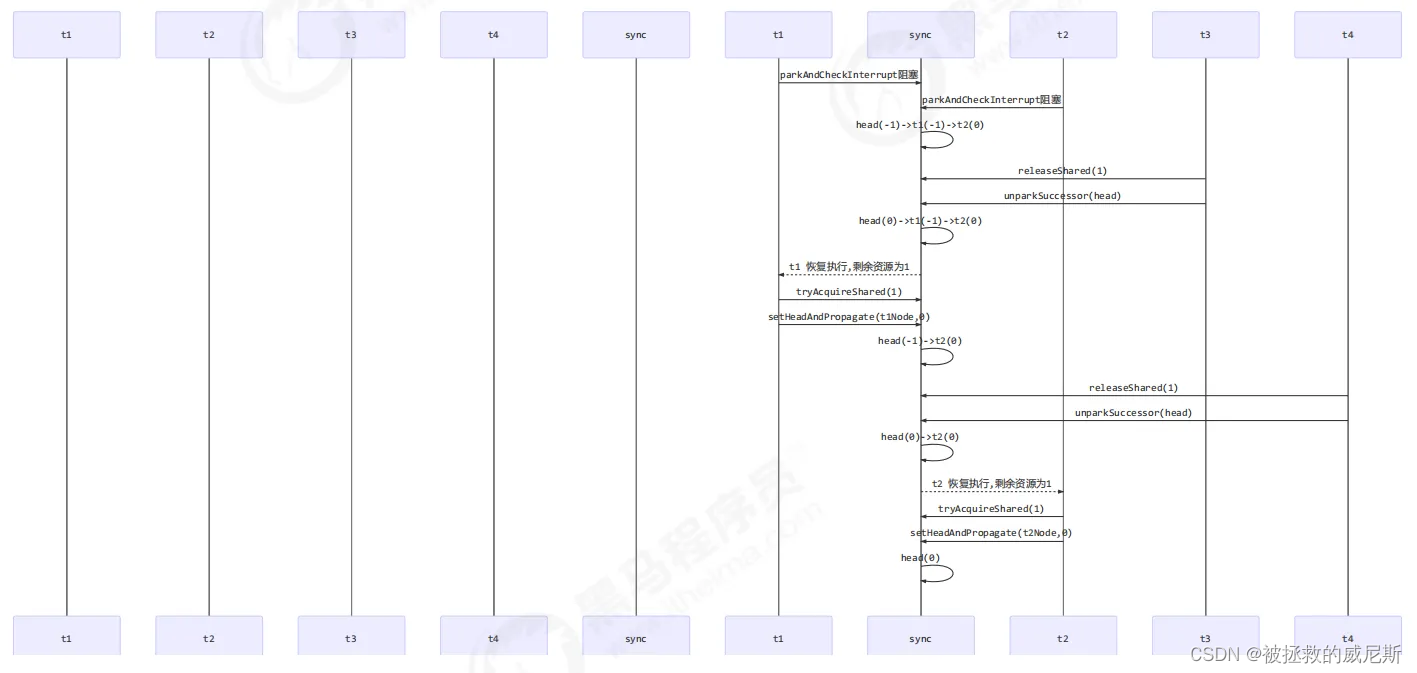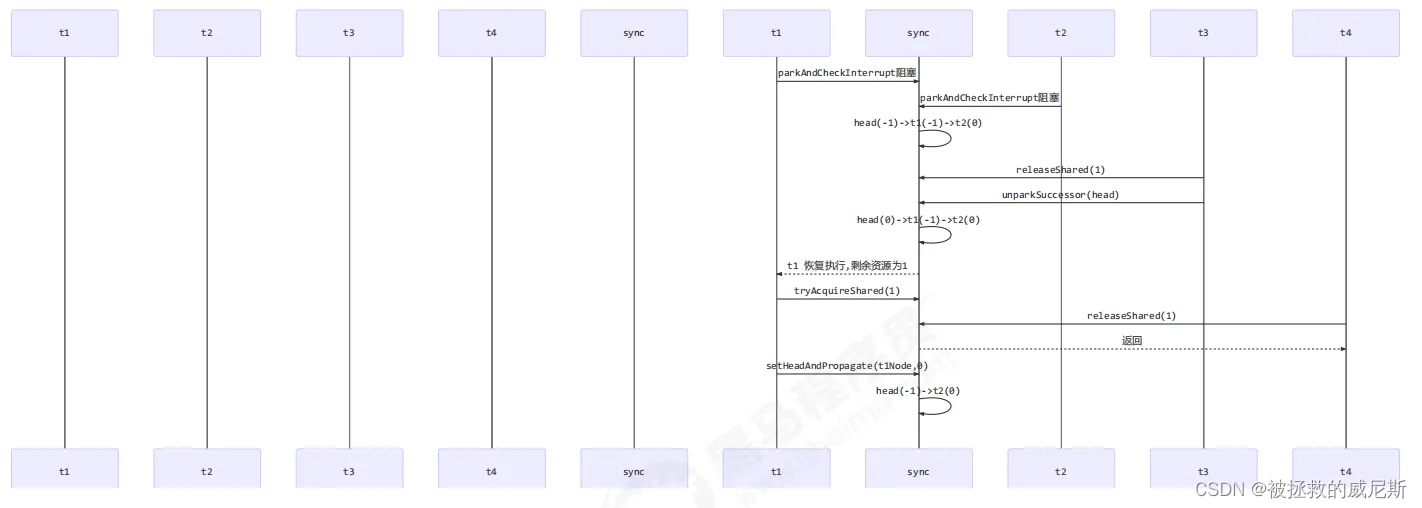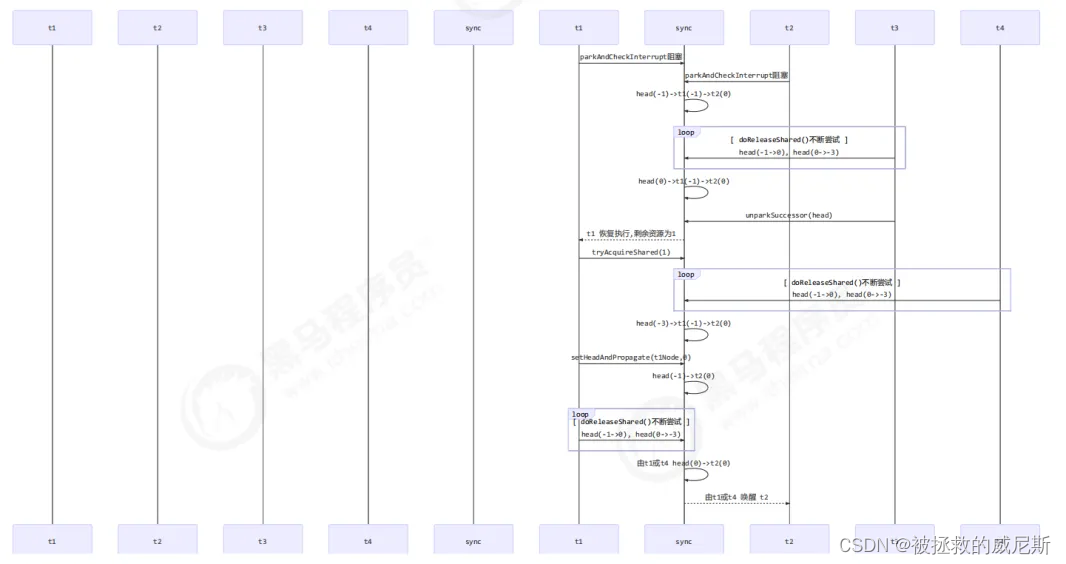1. Semaphore
信号量
基本使用
[ˈsɛməˌfɔr] 信号量,用来限制能同时访问共享资源的线程上限。
public static void main(String[] args) {// 1. 创建 semaphore 对象Semaphore semaphore = new Semaphore(3);// 2. 10个线程同时运行for (int i = 0; i < 10; i++) {new Thread(() -> {// 3. 获取许可try {semaphore.acquire();} catch (InterruptedException e) {e.printStackTrace();}try {log.debug("running...");sleep(1);log.debug("end...");} finally {// 4. 释放许可semaphore.release();}}).start();}}
结果
07:35:15.485 c.TestSemaphore [Thread-2] - running...
07:35:15.485 c.TestSemaphore [Thread-1] - running...
07:35:15.485 c.TestSemaphore [Thread-0] - running...
07:35:16.490 c.TestSemaphore [Thread-2] - end...
07:35:16.490 c.TestSemaphore [Thread-0] - end...
07:35:16.490 c.TestSemaphore [Thread-1] - end...
07:35:16.490 c.TestSemaphore [Thread-3] - running...
07:35:16.490 c.TestSemaphore [Thread-5] - running...
07:35:16.490 c.TestSemaphore [Thread-4] - running...
07:35:17.490 c.TestSemaphore [Thread-5] - end...
07:35:17.490 c.TestSemaphore [Thread-4] - end...
07:35:17.490 c.TestSemaphore [Thread-3] - end...
07:35:17.490 c.TestSemaphore [Thread-6] - running...
07:35:17.490 c.TestSemaphore [Thread-7] - running...
07:35:17.490 c.TestSemaphore [Thread-9] - running...
07:35:18.491 c.TestSemaphore [Thread-6] - end...
07:35:18.491 c.TestSemaphore [Thread-7] - end...
07:35:18.491 c.TestSemaphore [Thread-9] - end...
07:35:18.491 c.TestSemaphore [Thread-8] - running...
07:35:19.492 c.TestSemaphore [Thread-8] - end...
* Semaphore 应用 (实现简单连接池)
● 使用 Semaphore 限流,在访问高峰期时,让请求线程阻塞,高峰期过去再释放许可,当然它只适合限制单机线程数量,并且仅是限制线程数,而不是限制资源数(例如连接数,请对比 Tomcat LimitLatch 的实现)
● 用 Semaphore 实现简单连接池,对比『享元模式』下的实现(用wait notify),性能和可读性显然更好,注意下面的实现中线程数和数据库连接数是相等的
@Slf4j(topic = "c.Pool")
class Pool {// 1. 连接池大小private final int poolSize;// 2. 连接对象数组private Connection[] connections;// 3. 连接状态数组 0 表示空闲, 1 表示繁忙private AtomicIntegerArray states;private Semaphore semaphore;// 4. 构造方法初始化public Pool(int poolSize) {this.poolSize = poolSize;// 让许可数与资源数一致this.semaphore = new Semaphore(poolSize);this.connections = new Connection[poolSize];this.states = new AtomicIntegerArray(new int[poolSize]);for (int i = 0; i < poolSize; i++) {connections[i] = new MockConnection("连接" + (i+1));}}// 5. 借连接public Connection borrow() {// t1, t2, t3// 获取许可try {semaphore.acquire(); // 没有许可的线程,在此等待} catch (InterruptedException e) {e.printStackTrace();}for (int i = 0; i < poolSize; i++) {// 获取空闲连接if(states.get(i) == 0) {if (states.compareAndSet(i, 0, 1)) {log.debug("borrow {}", connections[i]);return connections[i];}}}// 不会执行到这里return null;}// 6. 归还连接public void free(Connection conn) {for (int i = 0; i < poolSize; i++) {if (connections[i] == conn) {states.set(i, 0);log.debug("free {}", conn);semaphore.release();break;}}}}
public static void main(String[] args) {Pool pool = new Pool(2);for (int i = 0; i < 5; i++) {new Thread(() -> {Connection conn = pool.borrow();try {Thread.sleep(1000);} catch (InterruptedException e) {e.printStackTrace();}pool.free(conn);}).start();}}
结果
已连接到地址为 ''127.0.0.1:14924',传输: '套接字'' 的目标虚拟机
10:34:36.915 c.Pool [Thread-0] - borrow MockConnection{name='连接1'}
10:34:36.915 c.Pool [Thread-2] - borrow MockConnection{name='连接2'}
10:34:37.927 c.Pool [Thread-2] - free MockConnection{name='连接2'}
10:34:37.927 c.Pool [Thread-0] - free MockConnection{name='连接1'}
10:34:37.928 c.Pool [Thread-1] - borrow MockConnection{name='连接1'}
10:34:37.928 c.Pool [Thread-3] - borrow MockConnection{name='连接2'}
10:34:38.936 c.Pool [Thread-1] - free MockConnection{name='连接1'}
10:34:38.936 c.Pool [Thread-3] - free MockConnection{name='连接2'}
10:34:38.936 c.Pool [Thread-4] - borrow MockConnection{name='连接1'}
10:34:39.945 c.Pool [Thread-4] - free MockConnection{name='连接1'}
已与地址为 ''127.0.0.1:14924',传输: '套接字'' 的目标虚拟机断开连
* Semaphore 原理
- 加锁解锁流程
Semaphore 有点像一个停车场,permits 就好像停车位数量,当线程获得了 permits 就像是获得了停车位,然后 停车场显示空余车位减一
刚开始,permits(state)为 3,这时 5 个线程来获取资源

假设其中 Thread-1,Thread-2,Thread-4 cas 竞争成功,而 Thread-0 和 Thread-3 竞争失败,进入 AQS 队列
park 阻塞

这时 Thread-4 释放了 permits,状态如下

接下来 Thread-0 竞争成功,permits 再次设置为 0,设置自己为 head 节点,断开原来的 head 节点,unpark 接下来的 Thread-3 节点,但由于 permits 是 0,因此 Thread-3 在尝试不成功后再次进入 park 状态

2. 源码分析
static final class NonfairSync extends Sync {private static final long serialVersionUID = -2694183684443567898L;NonfairSync(int permits) {// permits 即 statesuper(permits);}// Semaphore 方法, 方便阅读, 放在此处public void acquire() throws InterruptedException {sync.acquireSharedInterruptibly(1);}// AQS 继承过来的方法, 方便阅读, 放在此处public final void acquireSharedInterruptibly(int arg)throws InterruptedException {if (Thread.interrupted())throw new InterruptedException();if (tryAcquireShared(arg) < 0)doAcquireSharedInterruptibly(arg);}// 尝试获得共享锁protected int tryAcquireShared(int acquires) {return nonfairTryAcquireShared(acquires);}// Sync 继承过来的方法, 方便阅读, 放在此处final int nonfairTryAcquireShared(int acquires) {for (;;) {int available = getState();int remaining = available - acquires; if (// 如果许可已经用完, 返回负数, 表示获取失败, 进入 doAcquireSharedInterruptiblyremaining < 0 ||// 如果 cas 重试成功, 返回正数, 表示获取成功compareAndSetState(available, remaining)) {return remaining;}}}// AQS 继承过来的方法, 方便阅读, 放在此处private void doAcquireSharedInterruptibly(int arg) throws InterruptedException {final Node node = addWaiter(Node.SHARED);boolean failed = true;try {for (;;) {final Node p = node.predecessor();if (p == head) {// 再次尝试获取许可int r = tryAcquireShared(arg);if (r >= 0) {// 成功后本线程出队(AQS), 所在 Node设置为 head// 如果 head.waitStatus == Node.SIGNAL ==> 0 成功, 下一个节点 unpark// 如果 head.waitStatus == 0 ==> Node.PROPAGATE // r 表示可用资源数, 为 0 则不会继续传播setHeadAndPropagate(node, r);p.next = null; // help GCfailed = false;return;}}// 不成功, 设置上一个节点 waitStatus = Node.SIGNAL, 下轮进入 park 阻塞if (shouldParkAfterFailedAcquire(p, node) &&parkAndCheckInterrupt())throw new InterruptedException();}} finally {if (failed)cancelAcquire(node);}}// Semaphore 方法, 方便阅读, 放在此处public void release() {sync.releaseShared(1);}// AQS 继承过来的方法, 方便阅读, 放在此处public final boolean releaseShared(int arg) {if (tryReleaseShared(arg)) {doReleaseShared();return true;}return false;}// Sync 继承过来的方法, 方便阅读, 放在此处protected final boolean tryReleaseShared(int releases) {for (;;) {int current = getState();int next = current + releases;if (next < current) // overflowthrow new Error("Maximum permit count exceeded");if (compareAndSetState(current, next))return true;}}
}
3. 为什么要有 PROPAGATE
早期有 bug
● releaseShared 方法
public final boolean releaseShared(int arg) {if (tryReleaseShared(arg)) {Node h = head;if (h != null && h.waitStatus != 0)unparkSuccessor(h);return true;}return false; }
doAcquireShared 方法
private void doAcquireShared(int arg) {final Node node = addWaiter(Node.SHARED);boolean failed = true;try {boolean interrupted = false;for (;;) {final Node p = node.predecessor();if (p == head) {int r = tryAcquireShared(arg);if (r >= 0) {// 这里会有空档setHeadAndPropagate(node, r);p.next = null; // help GCif (interrupted)selfInterrupt();failed = false;return;}}if (shouldParkAfterFailedAcquire(p, node) &&parkAndCheckInterrupt())interrupted = true;}} finally {if (failed)cancelAcquire(node);}
}
setHeadAndPropagate 方法
private void setHeadAndPropagate(Node node, int propagate) {setHead(node);// 有空闲资源if (propagate > 0 && node.waitStatus != 0) {Node s = node.next;// 下一个if (s == null || s.isShared())unparkSuccessor(node);}
}
- 假设存在某次循环中队列里排队的结点情况为head(-1)->t1(-1)->t2(-1)
- 假设存在将要信号量释放的 T3 和 T4,释放顺序为先 T3 后 T4

产生bug的情况

修复前版本执行流程
-
- T3 调用 releaseShared(1),直接调用了 unparkSuccessor(head),head 的等待状态从 -1 变为 0
-
- T1 由于 T3 释放信号量被唤醒,调用 tryAcquireShared,假设返回值为 0(获取锁成功,但没有剩余资源 量)
-
- T4 调用 releaseShared(1),此时 head.waitStatus 为 0(此时读到的 head 和 1 中为同一个head),不满足条件,因此不调用 unparkSuccessor(head)
-
- T1 获取信号量成功,调用 setHeadAndPropagate 时,因为不满足 propagate > 0(2 的返回值也就是propagate(剩余资源量) == 0),从而不会唤醒后继结点, T2 线程得不到唤醒
bug 修复后
private void setHeadAndPropagate(Node node, int propagate) {Node h = head; // Record old head for check below// 设置自己为 headsetHead(node);// propagate 表示有共享资源(例如共享读锁或信号量)// 原 head waitStatus == Node.SIGNAL 或 Node.PROPAGATE// 现在 head waitStatus == Node.SIGNAL 或 Node.PROPAGATEif (propagate > 0 || h == null || h.waitStatus < 0 ||(h = head) == null || h.waitStatus < 0) {Node s = node.next;// 如果是最后一个节点或者是等待共享读锁的节点if (s == null || s.isShared()) {doReleaseShared();}}
}private void doReleaseShared() {// 如果 head.waitStatus == Node.SIGNAL ==> 0 成功, 下一个节点 unpark// 如果 head.waitStatus == 0 ==> Node.PROPAGATE for (;;) {Node h = head;if (h != null && h != tail) {int ws = h.waitStatus;if (ws == Node.SIGNAL) {if (!compareAndSetWaitStatus(h, Node.SIGNAL, 0))continue; // loop to recheck casesunparkSuccessor(h);}else if (ws == 0 &&!compareAndSetWaitStatus(h, 0, Node.PROPAGATE))continue; // loop on failed CAS}if (h == head) // loop if head changedbreak;}
}

-
- T3 调用 releaseShared(),直接调用了 unparkSuccessor(head),head 的等待状态从 -1 变为 0
-
- T1 由于 T3 释放信号量被唤醒,调用 tryAcquireShared,假设返回值为 0(获取锁成功,但没有剩余资源量)
-
- T4 调用 releaseShared(),此时 head.waitStatus 为 0(此时读到的 head 和 1 中为同一个 head),调用 doReleaseShared() 将等待状态置为 PROPAGATE(-3)
-
- T1 获取信号量成功,调用 setHeadAndPropagate 时,读到 h.waitStatus < 0,从而调用 doReleaseShared() 唤醒 T2




